Sergei Rachmaninoff
Sergei Vasilyevich Rachmaninoff[lower-alpha 1] (English: /rɑːxˈmɑːnəˌnɔːf, -ˌnɒf, rɑːk-/ rahkh-MAH-nə-nawf, -nof, rahk-;[3] Russian: Серге́й Васи́льевич Рахма́нинов[lower-alpha 2], tr. Sergei Vasilyevich Rakhmaninov, IPA: [sʲɪrˈɡʲej vɐˈsʲilʲjɪvʲɪt͡ɕ rɐxˈmanʲɪnəf]; 1 April [O.S. 20 March] 1873 – 28 March 1943[lower-alpha 3][lower-alpha 4]) was a Russian composer, virtuoso pianist, and conductor of the late Romantic period. The influence of Tchaikovsky, Rimsky-Korsakov, Balakirev, Mussorgsky, and other Russian composers is seen in his early works, later giving way to a personal style notable for song-like melodicism, expressiveness and rich orchestral colors.[4]
Sergei Rachmaninoff | |
|---|---|
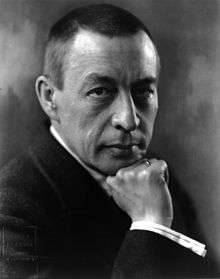 | |
| Signature | |
Born into a musical family, Rachmaninoff took up the piano at the age of four. He graduated from the Moscow Conservatory in 1892, having already composed several piano and orchestral pieces. In 1897, following the negative critical reaction to his Symphony No. 1, Rachmaninoff entered a four-year depression and composed little until successful therapy allowed him to complete his enthusiastically received Piano Concerto No. 2 in 1901. In the course of the next sixteen years, Rachmaninoff conducted at the Bolshoi Theatre, relocated to Dresden, Germany, and toured the United States for the first time. Rachmaninoff often featured the piano in his compositions, and he explored the expressive possibilities of the instrument through his own skills as a pianist.
Following the Russian Revolution, Rachmaninoff and his family left Russia. They settled in New York City in 1918. With his main source of income coming from piano and conducting performances, demanding tour schedules led to a reduction in his time for composition. Between 1918 and 1943, he completed just six works, including Rhapsody on a Theme of Paganini, Symphony No. 3, and Symphonic Dances. By 1942, his failing health led to his relocation to Beverly Hills, California. One month before his death from advanced melanoma, Rachmaninoff was granted American citizenship.
Biography
Ancestry and early years, 1873–1885
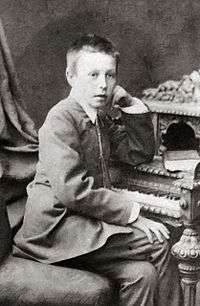
Rachmaninoff was born into a family of the Russian aristocracy in the Russian Empire. The family name can be traced back to the 1400s when Yelena, the daughter of Stephen IV of Moldavia, married the eldest son of Ivan III Vasilyevich, Grand Prince of Moscow. A son named Vasily was nicknamed "Rachmanin", meaning "lazy" in Old Russian.[5][6][7]
Rachmaninoff's family had strong musical and military leanings. His paternal grandfather, Arkady Alexandrovich, was a musician who had taken lessons from Irish composer John Field.[5] His father, Vasily Arkadyevich Rachmaninoff (1841–1916), was an army officer and amateur pianist who married Lyubov Petrovna Butakova (1853–1929), the daughter of a wealthy army general who gave her five estates as part of her dowry. The couple had three sons and three daughters, Sergei being their fourth child.[8]
It is unclear on which of the two family estates Rachmaninoff was born; either Oneg, near Veliky Novgorod, or Semyonovo, near Staraya Russa. His birth was registered in a church in the latter district[9], but he was raised in Oneg until aged nine and he himself cited it as his birthplace in his adult life.[10][11] Rachmaninoff began piano and music lessons organised by his mother at age four.[10] She noticed his ability to reproduce passages from memory without a wrong note. Upon hearing news of the boy's gift, Arkady suggested she hire Anna Ornatskaya, a teacher and recent graduate of the Saint Petersburg Conservatory, to live with the family and begin formal teaching. Rachmaninoff dedicated his piano composition "Spring Waters" from 12 Romances, Op. 14 to Ornatskaya.[12]
Rachmaninoff's father had to auction off the Oneg estate in 1882 due to his financial incompetence; the family's five estates were now reduced to one. Rachmaninoff remained critical of his father in later life, describing him as "a wastrel, a compulsive gambler, a pathological liar, and a skirt chaser".[13][14] The family moved to a small flat in Saint Petersburg.[15] In 1883, Ornatskaya arranged for Rachmaninoff, now 10, to study music at the Saint Petersburg Conservatory. Later that year his sister Sofia died of diphtheria and his father left the family for Moscow.[8] His maternal grandmother stepped in to help raise the children with particular focus on their spiritual life, regularly taking Rachmaninoff to Russian Orthodox Church services where he first experienced liturgical chants and church bells, two features he would incorporate in his future compositions.[15]
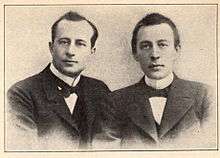
In 1885, Rachmaninoff suffered further loss when his sister Yelena died at age eighteen of pernicious anemia. She was an important musical influence to Rachmaninoff who had introduced him to the works of Pyotr Ilyich Tchaikovsky. As a respite, his grandmother took him to a farm retreat by the Volkhov River where Rachmaninoff developed a love for rowing.[8] At the Conservatory, however, he had adopted a relaxed attitude and failed his general education classes, and purposely altered his report cards in what composer Nikolai Rimsky-Korsakov called a period of "purely Russian self-delusion and laziness".[16] Rachmaninoff performed at events held at the Moscow Conservatory during this time, including those attended by the Grand Duke Konstantin and other notable figures, but upon his failing his spring exams Ornatskaya notified his mother that his admission to further education might be revoked.[8] His mother then consulted with Alexander Siloti, her nephew and an accomplished pianist and student of Franz Liszt, who recommended he be transferred to the Moscow Conservatory and receive lessons from his former teacher, the more strict Nikolai Zverev,[17][18] which lasted until 1888.[19]
Moscow Conservatory and first compositions, 1885–1894
In the autumn of 1885, Rachmaninoff moved in with Zverev and stayed for almost four years, during which he befriended fellow pupil Alexander Scriabin.[20] After two years of tuition, the fifteen year old Rachmaninoff was awarded a Rubinstein scholarship,[21] and graduated from the lower division of the Conservatory to become a pupil of Siloti in advanced piano, Sergei Taneyev in counterpoint, and Anton Arensky in free composition.[22] In 1889, a rift formed between Rachmaninoff and Zverev, now his adviser, after Zverev turned down the composer's request for assistance in renting a piano and greater privacy to compose. Zverev, who believed composition was a waste for talented pianists, refused to speak to Rachmaninoff for some time and organised for him to live with his uncle and aunt Satin and their family in Moscow.[23] Rachmaninoff then found his first romance in Vera, the youngest daughter of the neighbouring Skalon family, but her mother objected and forbade Rachmaninoff to write to her, leaving him to correspond with her older sister Natalia.[24] It is from these letters that many of Rachmaninoff's earliest compositions can be traced.[17]
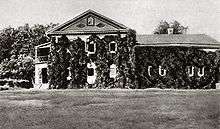
Rachmaninoff spent his summer break in 1890 with the Satins at Ivanovka, their private country estate near Tambov, to which the composer would return many times until 1917.[25] The peaceful and bucolic surroundings became a source of inspiration for the composer who completed many compositions while at the estate, including his Op. 1, the Piano Concerto No. 1, which he dedicated to Siloti, in July 1891.[26] Also that year, Rachmaninoff completed the one-movement Youth Symphony and the symphonic poem Prince Rostislav.[8] Siloti left the Moscow Conservatory after the academic year ended in 1891 and Rachmaninoff asked to take his final piano exams a year early to avoid being assigned a different teacher. Despite little faith from Siloti and Conservatory director Vasily Safonov as he had just three weeks' preparation, Rachmaninoff received assistance from a recent graduate who was familiar with the tests, and passed each one with honours in July 1891. Three days later, he passed his annual theory and composition exams.[27] His progress was unexpectedly halted in the latter half of 1891 when he contracted a severe case of malaria during his summer break at Ivankova.[28][29]
During his final year at the Conservatory, Rachmaninoff performed his first independent concert, where he premiered his Trio élégiaque No. 1 in February 1892, followed by a performance of the first movement of his Piano Concerto No. 1 a month later.[30] His request to take his final theory and composition exams a year early was also granted, for which he wrote Aleko, a one-act opera based on the narrative poem The Gypsies by Alexander Pushkin, in seventeen days.[31][26][32] It premiered in May 1892 at the Bolshoi Theatre which Tchaikovsky attended and praised Rachmaninoff for his work.[33] Rachmaninoff believed it was "sure to fail", but the production was so successful the theatre agreed to produce it starring singer Feodor Chaliapin who would become a lifelong friend.[34][17] Aleko earned Rachmaninoff the highest mark at the Conservatory and a Great Gold Medal, a distinction only previously awarded to Taneyev and Arseny Koreshchenko.[17] Zverev, a member of the exam committee, gave the composer his gold watch, thus ending years of estrangement.[35] On 29 May 1892, the Conservatory issued Rachmaninoff with a diploma which allowed him to officially style himself as a "Free Artist".[8]
Upon graduating, Rachmaninoff continued to compose and signed a 500-ruble publishing contract with Gutheil, under which Aleko, Two Pieces (Op. 2) and Six Songs (Op. 4) were among the first published.[35] The composer had previously earned 15 rubles a month in giving piano lessons.[36] He spent the summer of 1892 on the estate of Ivan Konavalov, a rich landowner in the Kostroma Oblast, and moved back with the Satins in the Arbat District.[8] Delays in getting paid by Gutheil saw Rachmaninoff seeking other sources of income which led to an engagement at the Moscow Electrical Exhibition in September 1892, his public debut as a pianist, where he premiered his landmark Prelude in C-sharp minor from his five-part piano composition piece Morceaux de fantaisie (Op. 3). He was paid 50 rubles for his appearance.[37][35][38] It was well received and became one of his most enduring pieces.[39][40] In 1893, he completed his tone poem The Rock, dedicated to Rimsky-Korsakov.
In 1893, Rachmaninoff spent a productive summer with friends at an estate in Kharkiv Oblast where he composed several pieces, including Fantaisie-Tableaux (aka Suite No. 1, Op. 5) and Morceaux de salon (Op. 10).[41][42] In September, he published Six Songs (Op. 8), a group of songs set to translations by Aleksey Pleshcheyev of Ukrainian and German poems.[43] Rachmaninoff returned to Moscow, where Tchaikovsky agreed to conduct The Rock for an upcoming European tour. During his subsequent trip to Kiev to conduct performances of Aleko, he learned of Tchaikovsky's death from cholera.[44] The news left Rachmaninoff stunned; later that day, he started work on his Trio élégiaque No. 2 for piano, violin and cello as a tribute, which he completed within a month.[45][46] The music's aura of gloom reveals the depth and sincerity of Rachmaninoff's grief for his idol.[47] The piece debuted at the first concert devoted to Rachmaninoff's compositions on 31 January 1894.[46]
Symphony No. 1, depression, and conducting debut, 1894–1900
Rachmaninoff entered a decline following Tchaikovsky's death. He lacked the inspiration to compose, and the management of the Grand Theatre had lost interest in showcasing Aleko and dropped it from the program.[48] To earn more money, Rachmaninoff returned to giving piano lessons,[49] and in late 1895 agreed to a three-month tour across Russia with a program shared by Italian violinist Teresina Tua. The tour was not enjoyable for the composer and he quit before it ended, thus sacrificing his performance fees. In a more desperate plea for money, Rachmaninoff pawned his gold watch given to him by Zverev.[50] In September 1895, before the tour started, Rachmaninoff completed his Symphony No. 1 (Op. 13), a work conceived in January and based on chants he had heard in Russian Orthodox church services.[50] Rachmaninoff had worked so hard on it that he could not return to composition until he heard the piece performed.[51] This lasted until October 1896, when "a rather large sum of money" that was not his was stolen from Rachmaninoff during a train journey and he had to work to recoup the losses. Among the pieces composed were Six Choruses (Op. 15) and Six moments musicaux (Op. 16), his final completed composition for several months.[52]
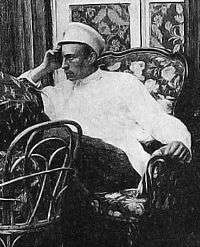
Rachmaninoff's fortunes took a turn following the premiere of his Symphony No. 1 on 28 March 1897 in one of a long-running series of Russian Symphony Concerts devoted to Russian music. Rachmaninoff had been considerably nervous before the performance, hiding in a staircase.[53] The piece was brutally panned by critic and nationalist composer César Cui, who likened it to a depiction of the ten plagues of Egypt, suggesting it would be admired by the "inmates" of a music conservatory in Hell.[54] The deficiencies of the performance, conducted by Alexander Glazunov, were not commented on by other critics,[47] but according to a memoir from Alexander Ossovsky, a close friend of Rachmaninoff,[55][56] Glazunov made poor use of rehearsal time, and the concert's program itself, which contained two other premières, was also a factor. Other witnesses suggested that Glazunov, an alcoholic, may have been drunk, although this was never intimated by Rachmaninoff.[57][58] Following the reaction to his first symphony, Rachmaninoff wrote in May 1897 that "I'm not at all affected" by its lack of success or critical reaction, but felt "deeply distressed and heavily depressed by the fact that my Symphony ... did not please me at all after its first rehearsal." He thought its performance was poor, particularly Glazunov's contribution.[59] The piece was not performed for the rest of Rachmaninoff's life, but he revised it into a four-hand piano arrangement in 1898.
Rachmaninoff fell into a depression that lasted for three years, during which he had writer's block and composed almost nothing. He described this time as "Like the man who had suffered a stroke and for a long time had lost the use of his head and hands".[60] He made a living by giving piano lessons.[61] A stroke of good fortune came from Savva Mamontov, a Russian industrialist and founder of the Moscow Private Russian Opera Company, who offered Rachmaninoff the post of assistant conductor for the 1897–98 season. The cash-strapped composer accepted, conducting Samson and Delilah by Camille Saint-Saëns as his first opera on 12 October 1897.[62] By the end of February 1899, Rachmaninoff attempted composition and completed two short piano pieces, Morceau de Fantaisie and Fughetta in F major. Two months later, he travelled to London for the first time to perform and conduct, earning positive reviews.[63]
During his time conducting in Moscow, Rachmaninoff was engaged to Natalia Satina. However, the Russian Orthodox church and Satina's parents opposed their announcement, thwarting their plans for marriage. Rachmaninoff's depression worsened in late 1899 following an unproductive summer; he composed one song, "Fate", which later became one of his Twelve Songs (Op. 21), and left compositions for a proposed return visit to London unfulfilled.[64] In an attempt to revive his desire to compose, his aunt arranged for the writer Leo Tolstoy, whom Rachmaninoff greatly admired, to have the composer visit his home and receive words of encouragement. The visit was unsuccessful, doing nothing to help him compose with the fluency he had before.[65][66]
Recovery, emergence, and conducting, 1900–1906
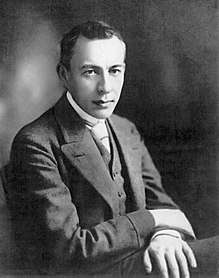
By 1900, Rachmaninoff had become so self-critical that, despite numerous attempts, composing had become near impossible. His aunt then suggested professional help, having received successful treatment from a family friend, physician and amateur musician Nikolai Dahl, to which Rachmaninoff agreed without resistance.[67] Between January and April 1900, Rachmaninoff underwent hypnotherapy and psychotherapy sessions with Dahl on a daily basis, specifically structured to improve his sleep patterns, mood, and appetite and reignite his desire to compose. That summer, Rachmaninoff felt that "new musical ideas began to stir" and successfully resumed composition.[68] His first fully completed work, the Piano Concerto No. 2, was finished in April 1901; it is dedicated to Dahl. After the second and third movement premiered in December 1900 with Rachmaninoff as the soloist, the entire piece was first performed in 1901 and was enthusiastically received.[69] The piece earned the composer a Glinka Award, the first of five awarded to him throughout his life, and a 500-rouble prize in 1904.[70]
Amid his professional career success, Rachmaninoff married Natalia Satina on 12 May 1902 after a three-year engagement.[71] Because they were first cousins, the marriage was forbidden under a Canon law imposed by the Russian Orthodox Church; in addition, Rachmaninoff was not a regular church attendee and avoided confession, two things a priest would have had to confirm that he did in signing a marriage certificate.[72] To circumvent the church's opposition, the couple used their military background and organised a small ceremony in a chapel in a Moscow suburb army barracks with Siloti and the cellist Anatoliy Brandukov as best men.[73] They received the smaller of two houses at the Ivanovka estate as a present and went on a three-month honeymoon across Europe.[71] Upon their return, they settled in Moscow, where they had two daughters, Irina Sergeievna Rachmaninova (1903–1969) and Tatiana Sergeievna Rachmaninova (1907–1961).[74][75][76] Rachmaninoff resumed work as a music teacher at St. Catherine's Women's College and the Elizabeth Institute.[77] By February 1903 he had completed his largest piano composition of his career at the time, the Variations on a Theme of Chopin (Op. 22).[77] Development on other pieces was disrupted after Natalia, Irina, and he were struck with illness during their summer break at Ivanovka.[78]
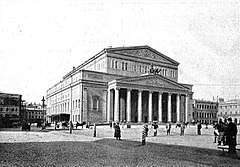
In 1904, in a career change, Rachmaninoff agreed to become the conductor at the Bolshoi Theatre for two seasons. He earned a mixed reputation during his time at the post, enforcing strict discipline and demanding high standards of performance.[79] Influenced by Richard Wagner, he pioneered the modern arrangement of the orchestra players in the pit and the modern custom of standing while conducting. He also worked with each soloist on their part, even accompanying them on the piano.[80] The theatre staged the premiere of his operas The Miserly Knight and Francesca da Rimini.[81]
In the course of his second season as conductor, Rachmaninoff lost interest in his post. The social and political unrest surrounding the 1905 Revolution was beginning to affect the performers and theatre staff, who staged protests and demands for improved wages and conditions. Rachmaninoff remained largely uninterested in the politics surrounding him and the revolutionary spirit had made working conditions increasingly difficult.[82] In February 1906, after conducting 50 performances in the first season and 39 in the second, Rachmaninoff handed in his resignation.[83] He then took his family on an extended tour around Italy with the hope of completing new works, but illness struck his wife and daughter, and they returned to Ivanovka.[84] Money soon became an issue following Rachmaninoff's resignation from his posts at St. Catherine's and Elizabeth schools, leaving him only the option of composing.[85]
Move to Dresden and first US tour, 1906–1917
Increasingly unhappy with the political turmoil in Russia and in need of seclusion from his lively social life to be able to compose, Rachmaninoff with his family left Moscow for Dresden, Germany, in November 1906.[86] The city had become a favourite of both Rachmaninoff and Natalia, presenting them with a more vibrant musical atmosphere and favourable opportunities. The family stayed in Dresden until 1909, only returning to Russia for their summer breaks at Ivanovka.[87] During a visit to Leipzig, he entered an art gallery which housed The Isle of the Dead by Arnold Böcklin. The painting served as the inspiration for Rachmaninoff's orchestral work of the same name, Op. 29.[88] Despite occasional periods of depression, apathy, and little faith in any of his work,[89] Rachmaninoff started on his Symphony No. 2 (Op. 27) in 1906, twelve years after the disastrous premiere of his first.[90] While writing it, Rachmaninoff and the family returned to Russia, but the composer detoured to Paris to take part in Sergei Diaghilev's season of Russian concerts in May 1907. His performance as the soloist in his Piano Concerto No. 2 with an encore of his Prelude in C-sharp minor was a triumphant success.[91] Rachmaninoff regained his sense of self-worth following the enthusiastic reaction to the premiere of his Symphony No. 2 in early 1908, which earned him his second Glinka Award and 1,000 roubles.[92]
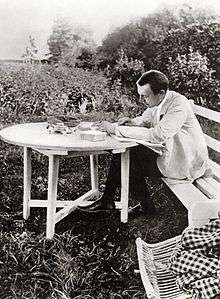
While in Dresden, Rachmaninoff agreed to perform and conduct in the United States as part of the 1909–10 concert season with conductor Max Fiedler and the Boston Symphony Orchestra.[93] He spent time during breaks at Ivanovka finishing a new piece specially for the visit, his Piano Concerto No. 3 (Op. 30), which he dedicated to Josef Hofmann.[94] The tour saw the composer make 26 performances, 19 as pianist and 7 as conductor, which marked his first recitals without another performer in the program. His first appearance was at Smith College in Northampton, Massachusetts for a recital on 4 November 1909. The second performance of the Piano Concerto No. 3 by the New York Symphony Orchestra was conducted by Gustav Mahler in New York City with the composer as soloist, an experience he personally treasured.[95][96] Though the tour increased the composer's popularity in America, he declined subsequent offers, including that of conductor of the Boston Symphony, due to the length of time away from Russia and his family.[97][98]
Upon his return home in February 1910, Rachmaninoff became vice president of the Imperial Russian Musical Society, whose president was a member of the royal family.[99] Later in 1910, Rachmaninoff completed his choral work Liturgy of St. John Chrysostom (Op. 31), but it was banned from performance as it did not follow the format of a typical liturgical church service.[100] For two seasons between 1911 and 1913, Rachmaninoff was appointed permanent conductor of the Philharmonic Society of Moscow; he helped raise its profile and increase audience numbers and receipts.[101] In 1912, Rachmaninoff left the IRMS when he learned that a musician in an administrative post was dismissed for being Jewish.[102]
Soon after his resignation, an exhausted Rachmaninoff sought time for composition and took his family on holiday to Switzerland. They left after one month for Rome for a visit that became a particularly tranquil and influential period for the composer, who lived alone in a small apartment on Piazza di Spagna while his family stayed at a boardinghouse.[103][104] While there he received an anonymous letter that contained a Russian translation of Edgar Allan Poe's poem The Bells by Konstantin Balmont, which affected him greatly, and he began work on his choral symphony of the same title, Op. 35, based on it.[105] This period of composition ended abruptly when Rachmaninoff's daughters contracted serious cases of typhoid and were treated in Berlin due to their father's greater trust in German doctors. After six weeks, the Rachmaninoffs returned to their Moscow flat.[106] The composer conducted The Bells at its premiere in Saint Petersburg in late 1913.[107]
In January 1914, Rachmaninoff began a concert tour of England which was enthusiastically received.[107] He was too afraid to travel alone following the death of Raoul Pugno of an unexpected heart attack in his hotel room which left the composer wary of a similar fate.[106] Following the outbreak of war later that year, his position of Inspector of Music at Nobility High School for Girls put him in the group of government servants which prevented him from joining the army, yet the composer made regular charitable donations for the war effort.[108] In 1915, Rachmaninoff completed his second major choral work, All-Night Vigil (Op. 37), after he attended a performance of the Liturgy of St. John Chrysostom and felt disappointed with it. After spending two weeks writing the All-Night Vigil, he passed the score to Sergei Taneyev for proofreading and correcting errors in its polyphony, but it was returned unaltered. It was received so warmly at its Moscow premiere in aid of war relief that four subsequent performances were quickly scheduled.[109]
Scriabin's death in April 1915 was a tragedy for Rachmaninoff, who went on a piano recital tour devoted to his friend's compositions to raise funds for Scriabin's financially stricken widow.[110] It marked his first public performances of works other than his own.[111] During a vacation in Finland that summer, Rachmaninoff learned of Taneyev's death, a loss which affected him greatly.[112] By year's end he had finished his 14 Romances (Op. 34), whose final section, Vocalise, became one of his most popular pieces.[113]
Leaving Russia, immigration to the US, and concert pianist, 1917–1925
On the day the February 1917 Revolution began in Saint Petersburg, Rachmaninoff performed a piano recital in Moscow in aid of wounded Russian soldiers who had fought in the war.[114] This was followed two months later with a visit to Ivanovka, where he found the house in chaos after a group of Social Revolutionary Party members seized it as their own communal property.[115] Despite having invested most of his earnings on the estate Rachmaninoff left after three weeks, vowing never to return.[116] It was soon confiscated by the communist authorities and became derelict.[117]
Following an August break with his family in the more peaceful Crimea, he performed at nearby Yalta on 5 September, which was to be his final concert in Russia. On his return to Moscow, the political tension surrounding the October Revolution found the composer keeping his family safe indoors as often as possible and being involved in a collective at his apartment building, attending committee meetings and carrying out civil guard duties at night. He completed revisions to his Piano Concerto No. 1 among gunshots and rallies outside.[118][119] Amidst such turmoil, Rachmaninoff received an unexpected offer to perform ten piano recitals across Scandinavia which he immediately accepted, using it as an excuse to quickly obtain permits for his family to leave the country.[120] On 22 December 1917, the Rachmaninoffs left Saint Petersburg by train to the Finnish border, from where they travelled through Finland on an open sledge and train to Helsinki. Carrying what they could pack into their small suitcases, Rachmaninoff brought some notebooks with sketches of compositions and scores to the first act of his unfinished opera Monna Vanna and Rimsky-Korsakov's opera The Golden Cockerel. They arrived in Stockholm, Sweden, on 24 December. In January 1918, they relocated to Copenhagen, Denmark, and, with the help of friend and composer Nikolai von Struve, settled on the ground floor of a house.[121] In debt and in need of money, the 44-year-old Rachmaninoff chose performing as his main source of income, as a career solely in composition was too restrictive.[122] His piano repertoire was small, which prompted the start of regular practise of his technique and learning new pieces to play. Rachmaninoff toured between February and October 1918.[123][124]
During the Scandinavian tour, Rachmaninoff received three offers from the US: to become the conductor of the Cincinnati Symphony Orchestra for two years, to conduct 110 concerts in 30 weeks for the Boston Symphony Orchestra, and to give 25 piano recitals.[124] He declined them all, worried about such a commitment in a country he hardly knew and had few fond memories of from his debut tour in 1909. Yet Rachmaninoff now considered the United States as financially advantageous, as he would not earn enough to support his family through composition alone. He was unable to afford the travel fees, but his fortunes changed when Russian banker and fellow emigre Alexander Kamenka agreed to give him an advance loan for the journey.[124] He also received assistance from friends and admirers; pianist Ignaz Friedman gave them $2,000.[122] On 1 November 1918, the family boarded the SS Bergensfjord in Oslo, Norway, bound for New York City, arriving eleven days later. News of Rachmaninoff's arrival spread, causing a crowd of musicians, artists, and fans to gather outside The Sherry-Netherland hotel where he was staying.[124]
Rachmaninoff quickly dealt with business, hiring Dagmar Rybner, daughter of the Professor of Music at Columbia University, as his secretary, interpreter, and aide in dealing with American life.[124] He reunited with Josef Hofmann who informed several concert managers that the composer was available and suggested that Rachmaninoff use the services of Charles Ellis as his booking agent. The composer agreed, and Ellis organised 36 performances for the 1918–1919 concert season; the first took place on 8 December 1918 at Providence, Rhode Island, with a piano recital. Rachmaninoff, still in recovery from a case of the Spanish flu, included his own arrangement of "The Star-Spangled Banner" in the program.[125] Before the tour he had received offers from numerous piano manufacturers to tour with their instruments, yet he chose Steinway, the only one that did not offer him money. Steinway's association with Rachmaninoff continued for the rest of his life.[126][127]
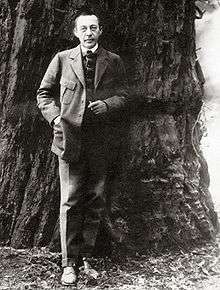
With the concert season over in April 1919, Rachmaninoff took his family on a break to San Francisco, California, where he recuperated and prepared for the upcoming season. He adopted such a schedule over the next several years, performing across the country followed by a period of rest and practise. Performing allowed him to become financially secure without much difficulty, and he and his family lived an upper middle class life with servants, a chef, and chauffeur.[128] They recreated the atmosphere of their Ivanovka estate in their New York City home, entertaining Russian guests, employing Russians and observing Russian customs.[129] Though he could speak some English, Rachmaninoff had all his correspondence translated into Russian.[130] He allowed himself some luxury, including quality tailored suits and the latest model of cars.[128]
In 1920, Rachmaninoff signed a recording contract with the Victor Talking Machine Company which earned him some much needed income and began his longtime association with RCA.[126] During a family holiday in Goshen, New York, that summer he learned of von Struve's accidental death, prompting Rachmaninoff to strengthen the ties he had with those still in Russia by arranging with his bank to send regular money and food parcels to his family, friends, students, and those in need.[131][132] Early 1921 saw Rachmaninoff apply for documentation to visit Russia, the only time he would do so after leaving the country, but progress ceased following his decision to undergo surgery for pain in his right temple. The operation failed to relieve his symptoms; he only found relief after having dental work later in the decade.[131] After leaving hospital, he purchased an apartment on 33 Riverside Drive on the Upper West Side of Manhattan, overlooking the Hudson River. There too he maintained a Russian atmosphere by observing Russian customs, serving Russian food, and employing Russian servants.[131]
Rachmaninoff's first visit to Europe since emigrating to the US occurred in May 1922 with concerts in London.[133] This was followed by the Rachmaninoffs and the Satins reuniting in Dresden, after which the composer prepared for a hectic 1922–1923 concert season of 71 performances in five months. For a while he rented a railway carriage that was fitted with a piano and belongings to save time packing and unpacking suitcases.[134] In 1924, Rachmaninoff declined an invitation to become conductor of the Boston Symphony Orchestra.[122] In the following year, after the death of the husband of his daughter Tatiana, he founded TAIR, a Paris publishing company named after his daughters and specialising in works by himself and other Russian composers.[135]
Touring, final compositions, and Villa Senar, 1926–1942
Demanding tour schedules caused Rachmaninoff's composition output to slow significantly; between his arrival to the US in 1918 and his death, he completed just six compositions barring some revisions to previous works and piano transcriptions for his concert repertoire.[136] The composer later admitted that by leaving Russia, "I left behind my desire to compose: losing my country, I lost myself also".[137] In 1926, after concentrating on touring for the past eight years, he took a year's break from performing and completed the first two of his last six pieces, the Piano Concerto No. 4, which he had started in 1917, and Three Russian Songs which he dedicated to Leopold Stokowski.[138][139] Rachmaninoff sought the company of fellow Russian musicians and befriended pianist Vladimir Horowitz in 1928.[140] The men remained supportive of each other's work, each making a point of attending concerts given by the other.[141] Horowitz remained a champion of Rachmaninoff's solo works and his Piano Concerto No. 3, about which Rachmaninoff remarked publicly after a performance in 1942: "This is the way I always dreamed my concerto should be played, but I never expected to hear it that way on Earth."[141] In 1930, in a rare occurrence, Rachmaninoff allowed Italian composer Ottorino Respighi to orchestrate pieces from his Études-Tableaux, Op. 33 (1911) and the Études-Tableaux, Op. 39 (1917), giving Respighi the inspirations behind the compositions.[142]
From 1929 to 1931, Rachmaninoff spent his summers in France at Clairefontaine-en-Yvelines near Rambouillet, meeting with fellow Russian émigrés and his daughters. By 1930, his desire to compose had returned and sought a new location to write new pieces. He bought a plot of land in Switzerland near Hertenstein, Lucerne and oversaw the construction of his new home, naming it Villa Senar after the first two letters of his and his wife's name, adding the "r" from the family name.[133][143] Rachmaninoff would spend the summer at Villa Senar until 1939, often with his daughters and grandchildren, with whom he would partake in one of his favourite activities, driving his motorboat on Lake Lucerne.[143] In the comfort of his own villa, Rachmaninoff completed his Rhapsody on a Theme of Paganini in 1934 and Symphony No. 3 in 1936.
In 1931, Rachmaninoff and several others signed an article in The New York Times that criticised the cultural policies of the Soviet Union. The composer's music suffered a boycott in Russia as a result from the backlash in the Soviet press, lasting until 1933.[133]
In October 1932, Rachmaninoff began a demanding concert season that consisted of 50 performances. The tour marked the fortieth anniversary of his debut as a pianist, for which several of his Russian friends now living in America sent him a scroll and wreath in celebration.[144] The frail economic situation in the US affected the tour and the composer, who performed to few sold-out audiences and lost money in his investments and shares. The European leg in 1933 saw Rachmaninoff celebrate his sixtieth birthday among fellow musicians and friends, after which he retreated to Villa Senar for the summer.[144] In May 1934, Rachmaninoff underwent a minor operation and completed Rhapsody on a Theme of Paganini during his stay at Senar. 1936 saw the composer retreat to Aix-les-Bains in France for a short period to improve his arthritis.[145] While visiting Senar in 1937, Rachmaninoff began talks with choreographer Michel Fokine about staging a ballet based on Paganini that was to feature his Rhapsody; it premiered in London in 1939 with the composer's daughters in attendance.[146] In 1938, Rachmaninoff performed his Second Piano Concerto at a charity jubilee concert in London for Henry Wood, founder of the Royal Albert Hall, London, Promenade concert series and an admirer of Rachmaninoff's who wanted the composer to be the show's only soloist. Rachmaninoff agreed, so long the performance was not broadcast on the radio due to his aversion for it.[147] The same concert featured the première of Vaughan Williams's Serenade to Music, on hearing which, Rachmaninoff was observed to weep.
The 1939–40 concert season saw Rachmaninoff perform fewer concerts than usual, totalling 43 appearances that were mostly in the US. The tour continued with dates across England, after which Rachmaninoff visited his daughter Tatyana in Paris followed by a return to Villa Senar. He was unable to perform for a while after slipping on the floor at the villa and injuring himself. He recovered enough to perform at the Lucerne International Music Festival on 11 August 1939. It was to be his final concert in Europe. He returned to Paris two days later, where Rachmaninoff, his wife, and two daughters were together for the last time before the composer left a now war-torn Europe on 23 August.[148][149] Rachmaninoff would support Russia's war effort against Nazi Germany throughout the course of World War II, donating receipts from many of his concerts that season in benefit of the Red Army.[150]
Upon his return to the US, Rachmaninoff performed with the Philadelphia Orchestra in New York City with conductor Eugene Ormandy on 26 November and 3 December 1939, as part of the orchestra's special series of concerts dedicated to the composer in celebration of the thirtieth anniversary of his US debut.[151] The final concert on 10 December saw Rachmaninoff conduct his Symphony No. 3 and The Bells, marking his first conducting post since 1917.[152][153] The concert season left Rachmaninoff tired, despite calling it "rather successful", and spent the summer resting from minor surgery at Orchard's Point, an estate near Huntington, New York on Long Island.[154][152] During this restful period Rachmaninoff completed his final composition, Symphonic Dances (Op. 45). It is his only piece he composed in its entirety while living in the US. Ormandy and the Philadelphia Orchestra premiered the piece in January 1941, which Rachmaninoff attended.[151]
In December 1939, Rachmaninoff began an extensive recording period which lasted until February 1942 and included his Piano Concerto Nos. 1 and 3 and Symphony No. 3 at the Philadelphia Academy of Music.[152] In the early 1940s, Rachmaninoff was approached by the makers of the British film Dangerous Moonlight to write a short concerto-like piece for use in the film, but he declined. The job went to Richard Addinsell and the orchestrator Roy Douglas, who came up with the Warsaw Concerto.[155]
Illness, move to California, and death, 1942–43
In early 1942, Rachmaninoff was advised by his doctor to relocate to a warmer climate to improve his health after suffering from sclerosis, lumbago, neuralgia, high blood pressure, and headaches.[156] After completing his final studio recording sessions during this time in February,[157] a move to Long Island fell through after the composer and his wife expressed a greater interest in California, and initially settled in a leased home on Tower Road in Beverly Hills in May.[156][151] In June they purchased a home at 610 North Elm Drive in Beverly Hills, living close to Horowitz who would often visit and perform piano duets with Rachmaninoff.[158][148] Later in 1942, Rachmaninoff invited Igor Stravinsky to dinner, the two sharing their worries of a war-torn Russia and their children in France.[159]
Shortly after a performance at the Hollywood Bowl in July 1942, Rachmaninoff was suffering from lumbago and fatigue. He informed his doctor, Alexander Golitsyn, that the upcoming 1942–43 concert season would be his last in order to dedicate his time to composition.[160][151] The tour began on 12 October 1942 and the composer received many positive reviews from critics despite his deteriorating health.[151] Rachmaninoff and his wife Natalia were among the 220 people who became naturalised American citizens at a ceremony held in New York City on 1 February 1943.[161][162] Later that month he complained of persistent cough and back pain; a doctor diagnosed him with pleurisy and advised that a warmer climate would aid in his recovery. Rachmaninoff opted to continue with touring, but felt so ill during his travels to Florida that the remaining dates were cancelled and he returned to California by train, where an ambulance took him to hospital. It was then that Rachmaninoff was diagnosed with an aggressive form of melanoma. His wife took Rachmaninoff home where he reunited with his daughter Irina.[163] His last appearances as a concerto soloist—Beethoven's First Piano Concerto and his Rhapsody on a Theme of Paganini—were on February 11 and 12 with the Chicago Symphony Orchestra under the baton of Hans Lange,[164] and his last recital, given on February 17 at the Alumni Memorial Gymnasium/Auditorium[165] at the University of Tennessee in Knoxville, Tennessee, included the Piano Sonata No. 2 by Chopin, which contains a funeral march.[166][167]
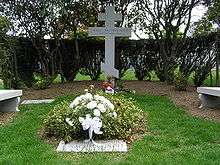
Rachmaninoff's health rapidly declined in the last week of March 1943. He was turned off by food, had constant pain in his arms and sides, and found it increasingly difficult to breathe. On 26 March, the composer lost consciousness and he died two days later, four days before his seventieth birthday.[168] A message from several Moscow composers with greetings had arrived too late for Rachmaninoff to read it.[168] His funeral took place at the Holy Virgin Mary Russian Orthodox Church on Micheltorena Street in Silver Lake.[169] In his will, Rachmaninoff wished to be buried at Novodevichy Cemetery in Moscow, the same as Scriabin, Taneyev, and Chekhov, but his American citizenship could not see the request through.[170] Instead, he was interred at Kensico Cemetery in Valhalla, New York on 1 June.[8]
In August 2015, Russia announced its intention to seek reburial of Rachmaninoff's remains in Russia, claiming that Americans have neglected the composer's grave while attempting to "shamelessly privatize" his name. The composer's descendants have resisted this idea, pointing out that he died in the U.S. after spending decades outside of Russia in self-imposed political exile.[171][172]
After Rachmaninoff's death, poet Marietta Shaginyan published fifteen letters they exchanged from their first contact in February 1912 and their final meeting in July 1917.[173] The nature of their relationship bordered on romantic, but was primarily intellectual and emotional. Shaginyan and the poetry she shared with Rachmaninoff has been cited as the inspiration for the six songs that make up his Six Songs, Op. 38.[174]
A statue marked "Rachmaninoff: The Last Concert", designed and sculpted by Victor Bokarev, stands at the World's Fair Park in Knoxville, Tennessee, as a tribute to the composer. In Alexandria, Virginia in 2019, a Rachmaninoff concert performed by the Alexandria Symphony Orchestra played to wide acclaim. Attendees were treated to a talk prior to the performance by Rachmaninoff's great-granddaughter, Natalie Wanamaker Javier, who joined esteemed Rachmaninoff scholar Francis Crociata (noted by the Alexandria Symphony Orchestra conductor James Ross as being the preeminent Rachmaninoff scholar in the world) and Library of Congress music specialist Kate Rivers on a panel of discussants about the composer and his contributions.[175]
Works
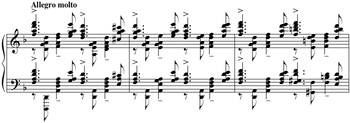
Rachmaninoff wrote five works for piano and orchestra: four concertos—No. 1 in F-sharp minor, Op. 1 (1891, revised 1917), No. 2 in C minor, Op. 18 (1900–01), No. 3 in D minor, Op. 30 (1909), and No. 4 in G minor, Op. 40 (1926, revised 1928 and 1941)—plus the Rhapsody on a Theme of Paganini. Of the concertos, the Second and Third are the most popular.[176]
Rachmaninoff also composed a number of works for orchestra alone. The three symphonies: No. 1 in D minor, Op. 13 (1895), No. 2 in E minor, Op. 27 (1907), and No. 3 in A minor, Op. 44 (1935–36). Widely spaced chronologically, the symphonies represent three distinct phases in his compositional development. The Second has been the most popular of the three since its first performance. Other orchestral works include The Rock (Op. 7), Caprice bohémien (Op. 12), The Isle of the Dead (Op. 29), and the Symphonic Dances (Op. 45).
Works for piano solo include 24 Preludes traversing all 24 major and minor keys; Prelude in C-sharp minor (Op. 3, No. 2) from Morceaux de fantaisie (Op. 3); ten preludes in Op. 23; and thirteen in Op. 32. Especially difficult are the two sets of Études-Tableaux, Op. 33 and 39, which are very demanding study pictures. Stylistically, Op. 33 hearkens back to the preludes, while Op. 39 shows the influences of Scriabin and Prokofiev. There are also the Six moments musicaux (Op. 16), the Variations on a Theme of Chopin (Op. 22), and the Variations on a Theme of Corelli (Op. 42). He wrote two piano sonatas, both of which are large scale and virtuosic in their technical demands. Rachmaninoff also composed works for two pianos, four hands, including two Suites (the first subtitled Fantasie-Tableaux), a version of the Symphonic Dances (Op. 45), and an arrangement of the C-sharp minor Prelude, as well as a Russian Rhapsody, and he arranged his First Symphony (below) for piano four hands. Both these works were published posthumously.
Rachmaninoff wrote two major a cappella choral works—the Liturgy of St. John Chrysostom and the All-Night Vigil (also known as the Vespers). It was the fifth movement of All-Night Vigil that Rachmaninoff requested to have sung at his funeral. Other choral works include a choral symphony, The Bells; the cantata Spring; the Three Russian Songs; and an early Concerto for Choir (a cappella).
He completed three one-act operas: Aleko (1892), The Miserly Knight (1903), and Francesca da Rimini (1904). He started three others, notably Monna Vanna, based on a work by Maurice Maeterlinck; copyright in this had been extended to the composer Février, and, though the restriction did not pertain to Russia, Rachmaninoff dropped the project after completing Act I in piano vocal score in 1908; this act was orchestrated in 1984 by Igor Buketoff and performed in the U.S. Aleko is regularly performed and has been recorded complete at least eight times, and filmed. The Miserly Knight adheres to Pushkin's "little tragedy". Francesca da Rimini exists somewhat in the shadow of the opera of the same name by Riccardo Zandonai.
His chamber music includes two piano trios, both of which are named Trio Elégiaque (the second of which is a memorial tribute to Tchaikovsky), and a Cello Sonata. He also composed many songs for voice and piano, to texts by A. N. Tolstoy, Pushkin, Goethe, Shelley, Hugo and Chekhov, among others. Among his most popular songs is the wordless Vocalise.
Compositional style
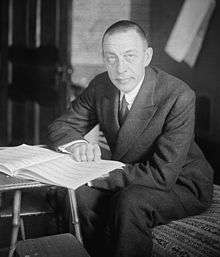
Rachmaninoff's style showed initially the influence of Tchaikovsky. Beginning in the mid-1890s, his compositions began showing a more individual tone. His First Symphony has many original features. Its brutal gestures and uncompromising power of expression were unprecedented in Russian music at the time. Its flexible rhythms, sweeping lyricism and stringent economy of thematic material were all features he kept and refined in subsequent works. After the three fallow years following the poor reception of the symphony, Rachmaninoff's style began developing significantly. He started leaning towards sumptuous harmonies and broadly lyrical, often passionate melodies. His orchestration became subtler and more varied, with textures carefully contrasted, and his writing on the whole became more concise.[177]
Especially important is Rachmaninoff's use of unusually widely spaced chords for bell-like sounds: this occurs in many pieces, most notably in the choral symphony The Bells, the Second Piano Concerto, the E-flat major Étude-Tableaux (Op. 33, No. 7), and the B minor Prelude (Op. 32, No. 10). "It is not enough to say that the church bells of Novgorod, St Petersburg and Moscow influenced Rachmaninov and feature prominently in his music. This much is self-evident. What is extraordinary is the variety of bell sounds and breadth of structural and other functions they fulfill."[178] He was also fond of Russian Orthodox chants. He used them most perceptibly in his Vespers, but many of his melodies found their origins in these chants. The opening melody of the First Symphony is derived from chants. (The opening melody of the Third Piano Concerto, on the other hand, is not derived from chants; when asked, Rachmaninoff said that "it had written itself".)[179]
Rachmaninoff's frequently used motifs include the Dies Irae, often just the fragments of the first phrase. Rachmaninoff had great command of counterpoint and fugal writing, thanks to his studies with Taneyev. The above-mentioned occurrence of the Dies Irae in the Second Symphony (1907) is but a small example of this. Very characteristic of his writing is chromatic counterpoint. This talent was paired with a confidence in writing in both large- and small-scale forms. The Third Piano Concerto especially shows a structural ingenuity, while each of the preludes grows from a tiny melodic or rhythmic fragment into a taut, powerfully evocative miniature, crystallizing a particular mood or sentiment while employing a complexity of texture, rhythmic flexibility and a pungent chromatic harmony.[180]
His compositional style had already begun changing before the October Revolution deprived him of his homeland. The harmonic writing in The Bells was composed in 1913 but not published until 1920. This may have been due to Rachmaninoff's main publisher, Gutheil, having died in 1914 and Gutheil's catalog being acquired by Serge Koussevitsky.[181] It became as advanced as in any of the works Rachmaninoff would write in Russia, partly because the melodic material has a harmonic aspect which arises from its chromatic ornamentation.[182] Further changes are apparent in the revised First Piano Concerto, which he finished just before leaving Russia, as well as in the Op. 38 songs and Op. 39 Études-Tableaux. In both these sets Rachmaninoff was less concerned with pure melody than with coloring. His near-Impressionist style perfectly matched the texts by symbolist poets.[183] The Op. 39 Études-Tableaux are among the most demanding pieces he wrote for any medium, both technically and in the sense that the player must see beyond any technical challenges to a considerable array of emotions, then unify all these aspects.[184]
The composer's friend Vladimir Wilshaw noticed this compositional change continuing in the early 1930s, with a difference between the sometimes very extroverted Op. 39 Études-Tableaux (the composer had broken a string on the piano at one performance) and the Variations on a Theme of Corelli (Op. 42, 1931). The variations show an even greater textural clarity than in the Op. 38 songs, combined with a more abrasive use of chromatic harmony and a new rhythmic incisiveness. This would be characteristic of all his later works—the Piano Concerto No. 4 (Op. 40, 1926) is composed in a more emotionally introverted style, with a greater clarity of texture. Nevertheless, some of his most beautiful (nostalgic and melancholy) melodies occur in the Third Symphony, Rhapsody on a Theme of Paganini, and Symphonic Dances.[183]
Music theorist and musicologist Joseph Yasser, as early as 1951, uncovered progressive tendencies in Rachmaninoff's compositions. He uncovered Rachmaninoff's use of an intra-tonal chromaticism that stands in notable contrast to the inter-tonal chromaticism of Richard Wagner and strikingly contrasts the extra-tonal chromaticism of the more radical twentieth century composers like Arnold Schoenberg. Yasser postulated that a variable, subtle, but unmistakable characteristic use of this intra-tonal chromaticism permeated Rachmaninoff's music.[185]
Fluctuating reputation
His reputation as a composer generated a variety of opinions before his music gained steady recognition around the world. The 1954 edition of the Grove Dictionary of Music and Musicians notoriously dismissed Rachmaninoff's music as "monotonous in texture ... consist[ing] mainly of artificial and gushing tunes" and predicted that his popular success was "not likely to last".[186] To this, Harold C. Schonberg, in his Lives of the Great Composers, responded: "It is one of the most outrageously snobbish and even stupid statements ever to be found in a work that is supposed to be an objective reference."[186]
The Conservatoire Rachmaninoff in Paris, as well as streets in Veliky Novgorod (which is close to his birthplace) and Tambov, are named after the composer. In 1986, the Moscow Conservatory dedicated a concert hall on its premises to Rachmaninoff, designating the 252-seat auditorium Rachmaninoff Hall, and in 1999 the "Monument to Sergei Rachmaninoff" was installed in Moscow. A separate monument to Rachmaninoff was unveiled in Veliky Novgorod, near his birthplace, on 14 June 2009.
Pianism
Technique
Rachmaninoff ranked among the finest pianists of his time, along with Leopold Godowsky, Ignaz Friedman, Moriz Rosenthal, Josef Lhévinne, Ferruccio Busoni, and Josef Hofmann, and he was famed for possessing a clean and virtuosic technique. His playing was marked by precision, rhythmic drive, notable use of staccato and the ability to maintain clarity when playing works with complex textures. Rachmaninoff applied these qualities in music by Chopin, including the B-flat minor Piano Sonata. Rachmaninoff's repertoire, excepting his own works, consisted mainly of standard 19th century virtuoso works plus music by Bach, Beethoven, Borodin, Debussy, Grieg, Liszt, Mendelssohn, Mozart, Schubert, Schumann and Tchaikovsky.[187]
Rachmaninoff possessed extremely large hands, with which he could easily maneuver through the most complex chordal configurations. His left hand technique was unusually powerful. His playing was marked by definition—where other pianists' playing became blurry-sounding from overuse of the pedal or deficiencies in finger technique, Rachmaninoff's textures were always crystal clear. Only Josef Hofmann and Josef Lhévinne shared this kind of clarity with him.[188] All three men had Anton Rubinstein as a model for this kind of playing—Hofmann as a student of Rubinstein's,[189] Rachmaninoff from hearing his famous series of historical recitals in Moscow while studying with Zverev,[190] and Lhevinne from hearing and playing with him.
The two pieces Rachmaninoff singled out for praise from Rubinstein's concerts became cornerstones for his own recital programs. The compositions were Beethoven's Appassionata and Chopin's Funeral March Sonata. He may have based his interpretation of the Chopin sonata on that of Rubinstein. Rachmaninoff biographer Barrie Martyn points out similarities between written accounts of Rubinstein's interpretation and Rachmaninoff's audio recording of the work.[191]
As part of his daily warm-up exercises, Rachmaninoff would play the technically difficult Étude in A-flat, Op. 1, No. 2, attributed to Paul de Schlözer.[192]
Tone
From those barely moving fingers came an unforced, bronzelike sonority and an accuracy bordering on infallibility.[193] Arthur Rubinstein wrote:
He had the secret of the golden, living tone which comes from the heart ... I was always under the spell of his glorious and inimitable tone which could make me forget my uneasiness about his too rapidly fleeting fingers and his exaggerated rubatos. There was always the irresistible sensuous charm, not unlike Kreisler's.[194]
Coupled to this tone was a vocal quality not unlike that attributed to Chopin's playing. With Rachmaninoff's extensive operatic experience, he was a great admirer of fine singing. As his records demonstrate, he possessed a tremendous ability to make a musical line sing, no matter how long the notes or how complex the supporting texture, with most of his interpretations taking on a narrative quality. With the stories he told at the keyboard came multiple voices—a polyphonic dialogue, not the least in terms of dynamics. His 1940 recording of his transcription of the song "Daisies" captures this quality extremely well. On the recording, separate musical strands enter as if from various human voices in eloquent conversation. This ability came from an exceptional independence of fingers and hands.[195]
Memory
Rachmaninoff also possessed an uncanny memory—one that would help put him in good stead when he had to learn the standard piano repertoire as a 45-year-old exile. He could hear a piece of music, even a symphony, then play it back the next day, the next year, or a decade after that. Siloti would give him a long and demanding piece to learn, such as Brahms' Variations and Fugue on a Theme by Handel. Two days later Rachmaninoff would play it "with complete artistic finish." Alexander Goldenweiser said, "Whatever composition was ever mentioned—piano, orchestral, operatic, or other—by a Classical or contemporary composer, if Rachmaninoff had at any time heard it, and most of all if he liked it, he played it as though it were a work he had studied thoroughly."[196]
Interpretations
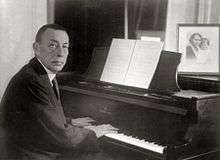
Regardless of the music, Rachmaninoff always planned his performances carefully. He based his interpretations on the theory that each piece of music has a "culminating point." Regardless of where that point was or at which dynamic within that piece, the performer had to know how to approach it with absolute calculation and precision; otherwise, the whole construction of the piece could crumble and the piece could become disjointed. This was a practice he learned from Russian bass Feodor Chaliapin, a staunch friend.[187] Paradoxically, Rachmaninoff often sounded like he was improvising, though he actually was not. While his interpretations were mosaics of tiny details, when those mosaics came together in performance, they might, according to the tempo of the piece being played, fly past at great speed, giving the impression of instant thought.[197]
One advantage Rachmaninoff had in this building process over most of his contemporaries was in approaching the pieces he played from the perspective of a composer rather than that of an interpreter. He believed "interpretation demands something of the creative instinct. If you are a composer, you have an affinity with other composers. You can make contact with their imaginations, knowing something of their problems and their ideals. You can give their works color. That is the most important thing for me in my interpretations, color. So you make music live. Without color it is dead."[198] Nevertheless, Rachmaninoff also possessed a far better sense of structure than many of his contemporaries, such as Hofmann, or the majority of pianists from the previous generation, judging from their respective recordings.[195]
A recording which showcases Rachmaninoff's approach is the Liszt Second Polonaise, recorded in 1925. Percy Grainger, who had been influenced by the composer and Liszt specialist Ferruccio Busoni, had himself recorded the same piece a few years earlier. Rachmaninoff's performance is far more taut and concentrated than Grainger's. The Russian's drive and monumental conception bear a considerable difference to the Australian's more delicate perceptions. Grainger's textures are elaborate. Rachmaninoff shows the filigree as essential to the work's structure, not simply decorative.[199]
Speculations about Marfan syndrome and acromegaly
Along with his musical gifts, Rachmaninoff possessed physical gifts that may have placed him in good stead as a pianist. These gifts included exceptional height and extremely large hands with a gigantic finger stretch (he could play the chord C E♭ G C G with his left hand). This and Rachmaninoff's slender frame, long limbs, narrow head, prominent ears, and thin nose suggest that he may have had Marfan syndrome, a hereditary disorder of the connective tissue. This syndrome would have accounted for several minor ailments he suffered all his life, including back pain, arthritis, eye strain, and bruising of the fingertips,[200] although others have pointed out that this was more likely because he was playing the piano all day long. This Marfan speculation was proposed by Dr. D. A. B. Young (formerly principal scientist of the Wellcome Foundation) in a 1986 British Medical Journal article. Twenty years later, an article in the Journal of the Royal Society of Medicine, by Ramachandran and Aronson differed greatly from Young's speculation:
The size of [Rachmaninov's] hands may have been a manifestation of Marfan's syndrome, their size and slenderness typical of arachnodactyly. However, Rachmaninov did not clearly exhibit any of the other clinical characteristics typical of Marfan's, such as scoliosis, pectus excavatum, and eye or cardiac complications. Nor did he express any of the clinical effects of a Marfan-related syndrome, such as Beal's syndrome (congenital contractural arachnodactyly), Ehlers-Danlos syndrome, homocystinuria, Stickler syndrome, or Sphrintzen-Goldberg syndrome. There is no indication that his immediate family had similar hand spans, ruling out familial arachnodactyly. Rachmaninov did not display any signs of digital clubbing or any obvious hypertrophic skin changes associated with pachydermoperiostitis.
Acromegaly is an alternative diagnosis. From photographs of Rachmaninov in the 1920s and his portrait by Konstantin Somov in 1925 (Figure 1), at a time when he was recording his four piano concerti, the coarse facial features of acromegaly are not immediately apparent. However, a case can be made from later photographs... During a heavy concert schedule in Russia in 1912, he interrupted his schedule because of stiffness in his hands. This may have been due to overuse, although carpal tunnel syndrome or simply swelling and puffiness of the hands associated with acromegaly may have been the cause. In 1942, Rachmaninov made a final revision of his troublesome Fourth Concerto but composed no more new music. A rapidly progressing melanoma forced him to break off his 1942–1943 concert tour after a recital in Knoxville, Tennessee. A little over five weeks later he died in the house he had bought the year before on Elm Drive in Beverly Hills. Melanoma is associated with acromegaly and may have been a final clue to Rachmaninov's diagnosis.
But then again, perhaps he just had big hands.[201]
Contrary to rumors that he was "six and a half feet" (198 cm), Rachmaninoff's height is documented in two U.S. Immigration manifests at Ellis Island, on 10 November 1918 and 30 October 1924, as being 6 ft 1 in (185 cm).[202] However, conductor Eugene Ormandy, who teamed with Rachmaninoff in many piano and orchestra performances, recalled in 1979: "He [Rachmaninoff] was about six feet-three (190 cm). I am five feet-five and a half (168 cm) ..."[203][204] Therefore, Rachmaninoff's height would also not be considered a physical deformity or abnormality.[205]
Recordings
Phonograph
Many of Rachmaninoff's recordings are acknowledged classics. In 1919, Rachmaninoff recorded a selection of piano pieces for Edison Records on their "Diamond Disc" records,[206] as they claimed the best audio fidelity in piano recording. Thomas Edison, who was quite deaf,[207] did not care for Rachmaninoff's playing, or for classical music in general, and referred to him as a "pounder" at their initial meeting.[208] However, staff at the Edison recording studio in New York City asked Edison to reconsider his dismissive position, resulting in a limited contract for ten released sides. Rachmaninoff recorded on a Lauter concert grand piano, one of the few the company made. He felt his performances varied in quality and requested final approval prior to a commercial release. Edison agreed, but still issued multiple takes, an unusual practice which was standard at Edison Records, where strict company policy demanded three good takes of each piece in case of damage or wear to the masters. Rachmaninoff and Edison Records were pleased with the released discs and wished to record more, but Edison refused, saying the ten sides were sufficient.
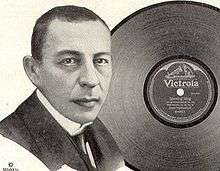
In 1920, Rachmaninoff signed a contract with the Victor Talking Machine Company (later RCA Victor). Unlike Edison, the company was pleased to comply with his requests, and proudly advertised Rachmaninoff as one of their prominent recording artists. He continued to record for Victor until 1942, when the American Federation of Musicians imposed a recording ban on their members in a strike over royalty payments. Rachmaninoff died in March 1943, over a year and a half before RCA Victor settled with the union and resumed commercial recording activity.
Particularly renowned are his renditions of Schumann's Carnaval and Chopin's Funeral March Sonata, along with many shorter pieces. He recorded all four of his piano concertos with the Philadelphia Orchestra, including two versions of the second concerto with Leopold Stokowski conducting (an abridged acoustical recording in 1924 and a complete electrical recording in 1929), and a world premiere recording of the Rhapsody on a Theme of Paganini, soon after the first performance (1934) with the Philadelphians under Stokowski. The first, third, and fourth concertos were recorded with Eugene Ormandy in 1939–41. Rachmaninoff also made three recordings conducting the Philadelphia Orchestra in his own Third Symphony, his symphonic poem Isle of the Dead, and his orchestration of Vocalise.[206] All of these recordings were reissued by RCA Victor in a 10-CD set "Sergei Rachmaninoff The Complete Recordings" (RCA Victor Gold Seal 09026-61265-2).
In an article for Gramophone, April 1931, Rachmaninoff defended an earlier stated view on the musical value of radio, about which he was sceptical: "the modern gramophone and modern methods of recording are musically superior to wireless transmission in every way".[209]
Piano rolls
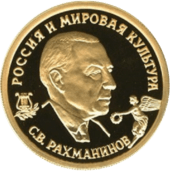
Rachmaninoff was also involved in various ways with music on piano rolls. Several manufacturers, and in particular the Aeolian Company, had published his compositions on perforated music rolls from about 1900 onwards.[210] His sister-in-law, Sofia Satina, remembered him at the family estate at Ivanovka, pedalling gleefully through a set of rolls of his Second Piano Concerto, apparently acquired from a German source,[211] most probably the Aeolian Company's Berlin subsidiary, the Choralion Company. Aeolian in London created a set of three rolls of this concerto in 1909, which remained in the catalogues of its various successors until the late 1970s.[212]
From 1919 he made 35 piano rolls (12 of which were his own compositions), for the American Piano Company (Ampico)'s reproducing piano. According to the Ampico publicity department, he initially disbelieved that a roll of punched paper could provide an accurate record, so he was invited to listen to a proof copy of his first recording. After the performance, he was quoted as saying "Gentlemen—I, Sergei Rachmaninoff, have just heard myself play!" For demonstration purposes, he recorded the solo part of his Second Piano Concerto for Ampico, though only the second movement was used publicly and has survived. He continued to record until around 1929, though his last roll, the Chopin Scherzo in B-flat minor, was not published until October 1933.[213]
Media
As performer |
As composer |
Films about Rachmaninoff
A film biography of Rachmaninoff titled Vetka sireni (Branch of Lilacs) and directed by Pavel Lungin was produced in Russia in 2007.
The 2015 musical Preludes by Dave Malloy depicts Rachmaninoff's struggle with depression and writer's block.
The Joy of Rachmaninoff (2016) is a documentary about Rachmaninoff's life.[214]
Use of Rachmaninoff's music in films
David Lean's 1945 film Brief Encounter uses excerpts from Rachmaninoff's Piano Concerto No. 2, which recur throughout the film, played by pianist Eileen Joyce.
Rachmaninoff's Piano Concerto No. 2 was featured in Billy Wilder's 1955 film The Seven Year Itch, starring Tom Ewell and Marilyn Monroe. The piece was played as an accompaniment to a fantasy seduction scene between the main characters.
Terrence Malick's 2013 film To the Wonder features Isle of the Dead.
Jeannot Szwarc's 1980 film Somewhere In Time features Rhapsody on a Theme of Paganini, Op. 43, Variation XVIII.
In the 1993 film Groundhog Day (film), Phil Connors (Bill Murray) learns to play Rhapsody on a Theme of Paganini on piano.
The 1996 film Shine features Rachmaninoff's Piano Concerto No. 3.
The 2011 film Limitless features Rachmaninoff's Prelude in C-sharp minor, Op. 3, No. 2.
Notes
- "Sergei Rachmaninoff" was the spelling he used while living in the United States from 1918 until his death. The Library of Congress standardised this usage.[1][2] His name is also commonly spelled "Rachmaninov" or "Rakhmaninov".
- Сергѣй Васильевичъ Рахманиновъ in Russian pre-revolutionary script.
- While the Library of Congress lists Rachmaninoff's birthdate as April 1,[2] his birthdate is listed as 2 April [O.S. 21 March] 1873 on his grave, and he himself celebrated his birthdate on April 2.
- Russia was using old style dates in the 19th century, and information sources used in the article sometimes report dates as old style rather than new style. Dates in the article are taken verbatim from the source and are in the same style as the source from which they come.
References
- "Sergey Rachmaninov". www.naxos.com. Retrieved 28 March 2018.
- "Name Authority File for Rachmaninoff, Sergei, 1873–1943". U.S. Library of Congress. 21 November 1980. Retrieved 2 April 2016.
- "Rachmaninoff". Random House Webster's Unabridged Dictionary.
- Norris, 707.
- Harrison 2006, p. 5.
- 1898–1973., Unbegaun, Boris Ottokar; 1898–1973., Унбегаун, Борис Оттокар (1989). Russkie familii. Uspenskiĭ, B. A. (Boris Andreevich), Успенский, Борис Андреевич. Moskva: Progress. ISBN 5010010453. OCLC 21065596.CS1 maint: numeric names: authors list (link)
- рахманный - это... Что такое рахманный?. Словари и энциклопедии на Академике (in Russian). Retrieved 18 July 2018.
- Harrison
- Harrison 2006, p. 6.
- Sylvester 2014, p. 2.
- Randel, Don M. (1999). The Harvard Concise Dictionary of Music and Musicians. Cambridge, Massachusetts: Harvard University Press (Belknap). ISBN 0-674-00978-9.
- Sylvester 2014, p. 3.
- Accardi, Julie Ciamporcero (2008). "Rach Bio". Rachmaninoff. Archived from the original on 21 November 2008. Retrieved 13 September 2008.
- Greene 1985, p. 1004.
- Riesemann 1934.
- Rimsky-Korsakov 1989, pp. 94–95.
- Bertensson & Leyda 2001, p. 46.
- Giulimondi, Gabriele (20 December 2000). "Sergei Rachmaninoff". The Internet Piano Page. Archived from the original on 12 January 2008. Retrieved 14 December 2007.
- Sylvester 2014, pp. 6–7.
- Harrison 2006, p. 15.
- Harrison 2006, p. 14.
- Seroff 1950, p. 27.
- Seroff 1950, p. 33, 35.
- Harrison 2006, p. 27.
- Harrison 2006, p. 26.
- Sylvester 2014, p. 8.
- Harrison 2006, p. 30.
- Seroff 1950, p. 41.
- Riesemann 1934, p. 75.
- Norris, Geoffrey (1993). The Master Musicians: Rachmaninoff. New York City: Schirmer Books. ISBN 0-02-870685-4.
- Lyle 1939, p. 75.
- "Sergei Rachmaninoff". San Francisco Symphony. 2007. Archived from the original on 13 December 2007. Retrieved 14 December 2007.
- Lyle 1939, pp. 83–85.
- Harrison 2006, p. 84–85.
- Cunningham 2001, p. 3.
- Lyle 1939, p. 82.
- Lyle 1939, p. 86.
- "Rachmaninov: Preludes Op. 23 / Cinq morceaux de fantaisie". Naxos Records. 2008. Archived from the original on 2 April 2012. Retrieved 15 March 2008.
- "Martin Werner Plays: Schubert – Schumann – Grieg – Chopin – Rachmaninoff – Felder". Guild Music. 31 May 2007. Retrieved 15 March 2008.
- "Sergei Rachmaninoff – Composer page". Boosey & Hawkes. 2008. Retrieved 21 March 2008.
- Sylvester 2014, p. 30.
- Threlfall & Norris 1982, p. 45.
- Bertensson & Leyda 2001, p. 61.
- Bertensson & Leyda 2001, p. 62.
- Lyle 1939, p. 91.
- Bertensson & Leyda 2001, p. 63.
- Norris, 709.
- Lyle 1939, p. 92.
- Lyle 1939, p. 93.
- Bertensson & Leyda 2001, p. 67.
- Bertensson & Leyda 2001, p. 69.
- Bertensson & Leyda 2001, p. 70.
- "The drunk conductor who ruined Rachmaninov's career". The Spectator. 18 October 2014.
- Kyui, Ts., "Tretiy russkiy simfonicheskiy kontsert," Novosti i birzhevaya gazeta (17 March 1897(o.s.)), 3.
- Harrison 2006, p. 77.
- Ossovsky Alexander Viacheslavovich (1871–1957), renowned critic and musicologist and close friend of Rachmaninoff, see external links.
- Lewis, Geraint. "Programme notes for Proms performance of Glazunov's Violin Concerto". BBC.
- Brown, David. "Liner Notes to a Deutsche Grammophon recording of Rachmaninoff's 3rd Symphony" conducted by Mikhail Pletnev
- Bertensson & Leyda 2001, p. 73.
- Bertensson & Leyda 2001, p. 74.
- Bertensson & Leyda 2001, p. 76.
- Bertensson & Leyda 2001, p. 77.
- Bertensson & Leyda 2001, p. 84, 87.
- Bertensson & Leyda 2001, p. 88.
- Harrison 2006, pp. 88–89.
- Riesemann 1934, p. 111.
- Bertensson & Leyda 2001, p. 89, 90.
- Bertensson & Leyda 2001, p. 90.
- Bertensson & Leyda 2001, p. 90, 95.
- Riesemann 1934, p. 242.
- Harrison 2006, p. 103.
- Bertensson & Leyda 2001, p. 97.
- Sylvester 2014, p. 94.
- "Xavier Bettel, un jeune libéral pressé". La Republicain Lorrain. 26 October 2013.
- Graaff, Laurent and Morang, Hubert (18 December 2013) Xavier Bettel "Vielleicht nicht der beliebteste Premier". Revue.lu
- Moraru, Clara Aniela Bettel Spiro-Rachmaninoff – Life is a precious gift, help people around you live the way you dream to live it yourself Archived 12 August 2014 at the Wayback Machine. women-leaders.eu
- Harrison 2006, p. 110.
- Harrison 2006, p. 113.
- Harrison 2006, pp. 113–114.
- Seroff 1950, p. 90.
- Bertensson & Leyda 2001, p. 102.
- Seroff 1950, pp. 92–93, 96.
- Harrison 2006, p. 114.
- Harrison 2006, p. 127.
- Seroff 1950, pp. 92–93, 96, 107.
- Lyle 1939, pp. 128–129.
- Seroff 1950, p. 108.
- Seroff 1950, p. 111.
- Seroff 1950, p. 112,114.
- Seroff 1950, p. 115.
- Seroff 1950, pp. 118–119.
- Harrison 2006, pp. 148–149.
- Lyle 1939, pp. 135, 142.
- Lyle 1939, p. 138.
- Lyle 1939, pp. 140–141.
- Harrison 2006, p. 160.
- Norris, 15:551.
- Harrison 2006, p. 162.
- Lyle 1939, p. 143.
- Lyle 1939, p. 146.
- Riesemann 1934, p. 166.
- Bertensson & Leyda 2001, p. 179.
- Seroff 1950, p. 172.
- Lyle 1939, pp. 149–150.
- Seroff 1950, pp. 172–173.
- Seroff 1950, pp. 174–175.
- Lyle 1939, pp. 152–153.
- Lyle 1939, p. 154.
- Scott 2011, pp. 108–109.
- Scott 2011, p. 111.
- Seroff 1950, p. 178.
- Scott 2011, p. 113.
- Lyle 1939, p. 147.
- Scott 2011, p. 117.
- Sylvester 2014, p. 257.
- Norris 2000, p. 51.
- Scott 2011, p. 118.
- Norris 2000, p. 52.
- Lyle 1939, p. 162.
- Scott 2011, p. 119.
- Norris 2000, p. 53.
- Wehrmeyer 2004, p. 88.
- Scott 2011, p. 120.
- Norris 2000, p. 54.
- Harrison 2006, p. 220.
- Norris 2000, p. 56.
- Scott 2011, p. 122.
- Wehrmeyer 2004, pp. 89–90.
- Norris, 15:554.
- Wehrmeyer 2004, p. 89.
- Harrison 2006, pp. 233–234.
- Norris 2000, p. 57.
- Wehrmeyer 2004, p. 126.
- Norris 2000, p. 58.
- Cunningham 2001, pp. 5–6.
- Wehrmeyer 2004, p. 102.
- "Sergei Rachmaninoff Biography". 8notes. Retrieved 2 March 2008.
- Wehrmeyer 2004, p. 103, 126.
- Cunningham 2001, p. 6.
- Plaskin, Glenn (1983) Horowitz – a biography. New York: William Morrow and Company. ISBN 0-688-01616-2. p. 107.
- "About Wizard Horowitz, Who Will Return Soon", The Milwaukee Journal, 18 April 1943, p. 66
- Bertensson & Leyda 2001, p. 262.
- Seroff 1950, p. 208.
- Norris 2000, p. 67.
- Norris 2000, p. 69.
- Norris 2000, p. 70.
- Norris 2000, p. 71.
- Norris 2000, p. 72.
- Harrison 2006, p. 322.
- Seroff 1950, p. 225.
- Norris 2000, p. 73.
- Harrison 2006, p. 323.
- The Royal Philharmonic Society; Retrieved 17 October 2013
- Harrison 2006, p. 330.
- "Richard Addinsell – Films as composer". filmreference.com. Retrieved 10 October 2008.
- Robinson 2007, p. 129.
- Harrison 2006, p. 340.
- Harrison 2006, p. 343.
- Wehrmeyer 2004, pp. 111–112.
- Harrison 2006, p. 344.
- Cunningham 2001.
- Cannata 1999, p. 24.
- Seroff 1950, pp. 230–231.
- Villella, Frank. From the Archives; Retrieved 6 February 2019
- Sherrod, Alan (11 February 2018). "Sergei Rachmaninoff, We Hardly Knew Ye".
- Norris, 15:554–555.
- Norris 2000, p. 75.
- Seroff 1950, pp. 230–232.
- Robinson 2007, p. 130.
- Wehrmeyer 2004, p. 113.
- Bigg, Claire (18 August 2015) Rachmaninoff Family Denounces Russian Officials' Reburial Push. Radio Free Europe
- "Russia: Rachmaninoff reburial bid riles composer's family". BBC. 19 August 2015. Retrieved 24 August 2017.
- Bertensson & Leyda 2001, p. 176.
- Simpson, Anne (1984). "Dear Re: A Glimpse into the Six Songs of Rachmaninoff's Opus 38". College Music Symposium. 24 (1): 97–106. JSTOR 40374219.
- Abbott, Eileen. "All things Rachmaninoff | Alexandria Times | Alexandria, VA". Alexandria Times. Retrieved 30 January 2020.
- Piano Concerto No. 2 has made the top 3 of Classic FM (UK)'s Hall Of Fame poll, an annual survey of classical music tastes, every year since 1996 including No. 1 in the 2011 poll. In a poll of classical music listeners announced in October 2007, the ABC in Australia found that Rachmaninoff's Second Piano Concerto came second, topped only by the "Emperor" Concerto of Beethoven. See ABC.net.au, Retrieved on 24 August 2010
- Norris, 714–715.
- Carruthers, Glen (2006). "The (re)appraisal of Rachmaninov's music: contradictions and fallacies". The Musical Times. 147 (1896): 44–50. doi:10.2307/25434403. JSTOR 25434403.
- Yasser, Joseph (1969). "The Opening Theme of Rachmaninoff's Third Piano Concerto and its Liturgical Prototype". Musical Quarterly. LV (3): 313–328. doi:10.1093/mq/LV.3.313.
- Norris, 715.
- Harrison 2006, p. 191.
- Harrison 2006, pp. 190–191.
- Norris, 716.
- Harrison 2006, p. 207.
- "Progressive Tendencies in Rachmaninoff's Music – Harmony – Pyotr Ilyich Tchaikovsky". Scribd.
- Schonberg 1998, Composers, p. 520.
- Norris, 714.
- Schonberg 1988, Virtuosi, p. 317.
- Schonberg, Pianists, 384.
- Riesemann 1934, p. 49–52.
- Martyn 1990, pp. 368, 403–406.
- "Jorge Bolet – Encores".
- Schonberg 1988, Virtuosi, p. 315.
- Rubinstein, 1980., 87–89, 468.
- Harrison 2006, p. 270.
- Schonberg 1998, Composers, p, 522.
- Harrison 2006, p. 268.
- Mayne, Basil (October 1936). "Conversations with Rachmaninoff". Musical Opinion.
- Harrison 2006, p. 251.
- Young, D.A.B. (1986). "Rachmaninov and Marfan's syndrome". British Medical Journal. 293 (6562): 1624–1626. doi:10.1136/bmj.293.6562.1624. PMC 1351877. PMID 3101945.
- Ramachandran, Manoj; Aronson, Jeffrey K. (2006). "The diagnosis of art: Rachmaninov's hand span". Journal of the Royal Society of Medicine. 99 (10): 529–530. doi:10.1258/jrsm.99.10.529. PMC 1592053. PMID 17066567.
- "SVR'S Height". Rachmaninoff.org. Retrieved 19 January 2014.
- Eugene Ormandy, in a conversation with Ed Cunningham, in Philadelphia. Radio station KUSC, of the USA's National Public Radio (NPR), broadcast excerpts of this conversation in 1979.
- "SVR's Vital Statistics". Rachmaninoff.org. Retrieved 19 January 2014.
- "Marfan syndrome". Rachmaninoff.org. Retrieved 19 January 2014.
- Online listing of Rachmaninoff's recording sessions (based on Martyn 1990, pp. 453–497). Retrieved 23 September 2016.
- "Thomas Edison".
When Edison was 14, he contracted scarlet fever. The effect of the fever, as well as a blow to the head by an angry train conductor, caused Edison to become completely deaf in his left ear, and 80-percent deaf in the other.
- Ziemann, George (October 2003), Thomas Edison, Intellectual Property and the Recording Industry, archived from the original on 10 October 2007, retrieved 14 May 2009
- Gramophone. "The most significant of modern musical inventions", Gramophone, April 1931
- "Music for the Pianola and the Aeriol Piano", The Aeolian Company, New York, July 1901.
- Harrison 2006, p. 223.
- "Catalogue of Music for the Pianola and Pianola-Piano", The Orchestrelle Company, London, June 1910, and many successive catalogues.
- Obenchain, Elaine. (1987) The Complete Catalog of Ampico Reproducing Piano Rolls (Vestal Press edition). Vestal, NY: Vestal Press. ISBN 0-911572-62-7.
- "DOCUMENTARY: The Joy of Rachmaninoff, BBC Four". Russian Art + Culture. 6 January 2016. Retrieved 3 December 2019.
Bibliography
- Bertensson, Sergei; Leyda, Jay (2001). Sergei Rachmaninoff – A Lifetime in Music (Paperback ed.). New York University Press. ISBN 978-0-253-21421-8.CS1 maint: ref=harv (link)
- Cannata, David Butler (1999). Rachmaninoff and The Symphony. Studien Verlag. ISBN 978-3-706-51240-4.CS1 maint: ref=harv (link)

- Cunningham, Robert E. (2001). Sergei Rachmaninoff: A Bio-bibliography. Greenwood Publishing Group. ISBN 978-0-313-30907-6.CS1 maint: ref=harv (link)
- Greene, David Mason (1985). Greene's Biographical Encyclopedia of Composers. Reproducing Piano Roll Foundation. ISBN 978-0-385-14278-6.CS1 maint: ref=harv (link)
- Harrison, Max (2006). Rachmaninoff: Life, Works, Recordings. Bloomsbury Publishing. ISBN 978-0-826-49312-5.CS1 maint: ref=harv (link)
- Lyle, Watson (1939). Rachmaninoff: A Biography. W. Reeves Bookseller Limited. ISBN 978-0-404-13003-9.CS1 maint: ref=harv (link)
- Martyn, Barrie (1990). Rachmaninoff: Composer, Pianist, Conductor. Scolar Press. ISBN 978-0-859-67809-4.CS1 maint: ref=harv (link)
- Norris, Geoffrey; Sadie, Stanley, eds. (1980). The New Grove Dictionary of Music and Musicians. MacMillan. ISBN 0-333-23111-2.
- Norris, Geoffrey (2000). Rachmaninoff. Oxford University Press. ISBN 978-0-198-16488-3.CS1 maint: ref=harv (link)
- Riesemann, Oskar von (1934). Rachmaninoff's Recollections, Told to Oskar von Riesemann. Macmillan. ISBN 978-0-836-95232-2.CS1 maint: ref=harv (link)
- Rimsky-Korsakov, Nikolai (1989). My Musical Life. Faber and Faber. ISBN 978-0-571-14245-3.CS1 maint: ref=harv (link)
- Robinson, Harlow (2007). Russians in Hollywood, Hollywood's Russians: Biography of an Image. UPNE. ISBN 978-1-555-53686-2.CS1 maint: ref=harv (link)
- Schonberg, Harold C. (1998). The Lives of the Great Composers (3 ed.). Abacus. ISBN 978-0-349-10972-5.
- Schonberg, Harold C. (1988). The Virtuosi: Classical Music's Great Performers From Paganini to Pavarotti. Vintage. ISBN 0-394-75532-4.
- Scott, Michael (2011). Rachmaninoff. The History Press. ISBN 978-0-7524-7242-3.CS1 maint: ref=harv (link)
- Seroff, Victor Ilyitch (1950). Rachmaninoff: A Biography. Simon & Schuster. ISBN 978-0-836-98034-9.CS1 maint: ref=harv (link)
- Sylvester, Richard D. (2014). Rachmaninoff's Complete Songs: A Companion with Texts and Translations. Indiana University Press. ISBN 978-0-2530-1259-3.CS1 maint: ref=harv (link)
- Threlfall, Robert; Norris, G. (1982). A Catalogue of the Compositions of Rachmaninoff. London: Scolar Press. ISBN 978-0-859-67617-5.CS1 maint: ref=harv (link)
- Wehrmeyer, Andreas (2004). Rakhmaninov. Haus Publishing. ISBN 1-904-34150-0.CS1 maint: ref=harv (link)
Further reading
- Norris, Geoffrey (2002). The Oxford Companion to Music. Oxford University Press. ISBN 0-19-866212-2. OCLC 59376677.
External links
| Wikiquote has quotations related to: Sergei Rachmaninoff |
| Wikimedia Commons has media related to Sergei Rachmaninoff. |
| Wikisource has the text of a 1922 Encyclopædia Britannica article about "Sergei Rachmaninoff". |
- Sergey Rachmaninoff at the Encyclopædia Britannica
- Sergei Rachmaninoff discography at MusicBrainz
- Sergei Rachmaninoff at AllMusic
- Serge Rachmaninoff's Performance Diary
- "Discovering Rachmaninov". BBC Radio 3.
- Serge Rachmaninoff Foundation and the Rachmaninoff Network
- Analysis of Rachmaninoff's Works for Piano and Orchestra
- Complete list of Rachmaninoff's performances as a conductor at the Wayback Machine (archived 27 October 2009)
- Faculty of Culture and Arts of Derzhavin Tambov State University
- Discography of Sergei Rachmaninoff on Victor Records from the Encyclopedic Discography of Victor Recordings (EDVR)
- 2008 radio program on the composer's place in Russian history (in Russian)
- Sergei Rachmaninoff archive, 1872-1992 at the Library of Congress
Free scores
- Works by Sergei Rachmaninoff at Project Gutenberg
- Works by or about Sergei Rachmaninoff at Internet Archive
- Free scores (in Italian)
- Free scores by Sergei Rachmaninoff at the International Music Score Library Project (IMSLP)
- Free scores by Sergei Rachmaninoff in the Choral Public Domain Library (ChoralWiki)